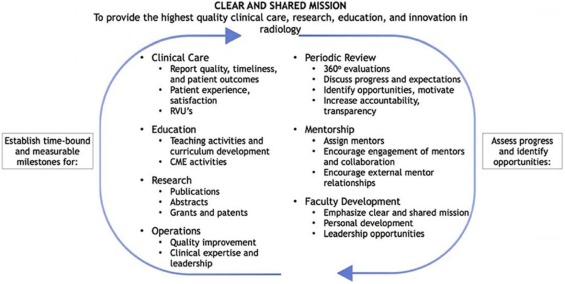Background of the Balanced Scorecard
In the early 1990s, Robert Kaplan and David Norton developed a strategic management system commonly known as the Balanced Scorecard (BSC). The initial aim of the BSC was to expand a company’s goals from simple financial metrics to include additional perspectives in an attempt to link a company’s short-term actions with its long-term strategy. Traditionally, the BSC incorporates metrics with goals from the point of view of customers, internal business process, and learning or growth . These metrics and goals are passed throughout the entire organization so employees can find ways to make their individual job or position fit with helping reach the larger corporate objectives.
BSC and Faculty Development
Many of the core principles of the BSC have been incorporated in various health-care settings, from large hospital management down to small private practice groups . Several of the tenets of the BSC can be applied to faculty development for radiologists in an academic setting to help in their career development and overall job satisfaction.
The transition from residency and fellowship to a faculty position can be difficult for a variety of reasons. Beginning a career in academic radiology often adds additional demands, and the pathway to full professorship can be daunting and nebulous. The intent of this paper is to illustrate how a newly hired faculty member and the department may work together to help in early career development. Figure 1 outlines a road map providing a continuing process of identifying opportunities, setting goals, and external and self-assessment that can help guide decision-making and help early-career faculty members prioritize their time and effort.
Ideally, a department has a solid foundation, including clear mission and vision statements. Mission and vision statements respectively strive to answer the questions “why do we exist?” and “who do we want to be?” By clearly identifying the overall mission of the department, it becomes more identifiable how each team member can contribute to achieving this mission. In our example, we have chosen a fairly broad mission statement: “to provide the highest clinical care, research, education, and innovation in radiology.” This simple statement aligns with many academic radiology departments throughout the country. However, subtle variations, differing emphasis, or rearrangement of core principles may help convey priorities and help focus the attention of team members.
In our example of how the BSC may be tailored to help in early faculty development, we have modified the traditional BSC perspectives to identify four new areas of concentration to help young faculty: clinical care, research, education, and operations (the left column of Fig 1 ). Additionally, examples of possible key metrics that could be tracked to help encourage success are listed. Identifying metrics that are meaningful and can be assessed is crucial. Hwa et al. used four criteria when establishing a BSC system for the hospitalist system at University of California, San Francisco.
Get Radiology Tree app to read full this article<
Get Radiology Tree app to read full this article<
Clinical Care
Get Radiology Tree app to read full this article<
Get Radiology Tree app to read full this article<
Education
Get Radiology Tree app to read full this article<
Research
Get Radiology Tree app to read full this article<
Operations or Finance
Get Radiology Tree app to read full this article<
Departmental Help and Contribution
Get Radiology Tree app to read full this article<
Get Radiology Tree app to read full this article<
Get Radiology Tree app to read full this article<
Conclusions
Get Radiology Tree app to read full this article<
References
1. Kaplan R.S., Norton D.P.: Using the balanced scorecard as a strategic management system. Harv Bus Rev 1996; 74: pp. 75-85.
2. Trotta A., Cardamone E., Cavallaro G., et. al.: Applying the balanced scorecard approach in teaching hospitals: a literature review and conceptual framework. Int J Health Plann Manage 2013; 28: pp. 181-201.
3. Rimar S., Garstka S.J.: The “Balanced Scorecard”: development and implementation in an academic clinical department. Acad Med 1999; 74: pp. 114-122.
4. Dugger C.: Balanced scorecard for the medical practice. AAOS Now 2014; 8: pp. 29-30.
5. Hwa M., Sharpe B.A., Wachter R.M.: Development and implementation of a balanced scorecard in an academic hospitalist group. J Hosp Med 2013; 8: pp. 148-153.
6. Berlin J.W., Lexa F.J.: Strategic planning for neuroradiologists. Neuroimaging Clin N Am 2012; 223: pp. 403-409.
7. Basu P.A., Ruiz-Wibbelsmann J.A., Spielman S.B., et. al.: Creating a patient-centered imaging service: determining what patients want. AJR Am J Roentgenol 2011; 196: pp. 605-610.
8. Gunderman R.B., Ballenger Z.: The golden rule of education. Acad Radiol 2014; 21: pp. 1078-1079.
9. Belfi L.M., Bartolotta R.J., Giambrone A.E., et. al.: “Flipping” the introductory clerkship in radiology. Acad Radiol 2015; 22: pp. 794-801.
10. Slanetz P.J., Kung J., Eisenberg R.L.: Teaching radiology in the millennial era. Acad Radiol 2013; 20: pp. 387-389.
11. Iyer R.S., Wood B.P.: Why do academic radiologists choose mentors?. Acad Radiol 2013; 20: pp. 921-922.
12. Slanetz P.J., Boiselle P.M.: Mentoring matters. AJR Am J Roentgenol 2012; 198: pp. W11-W12.
